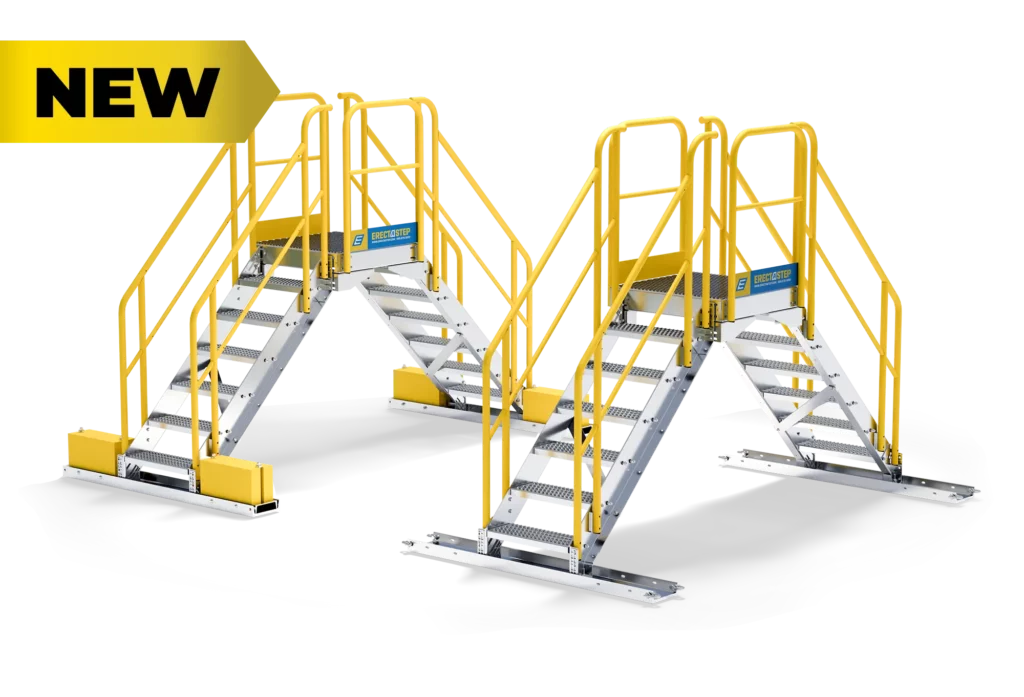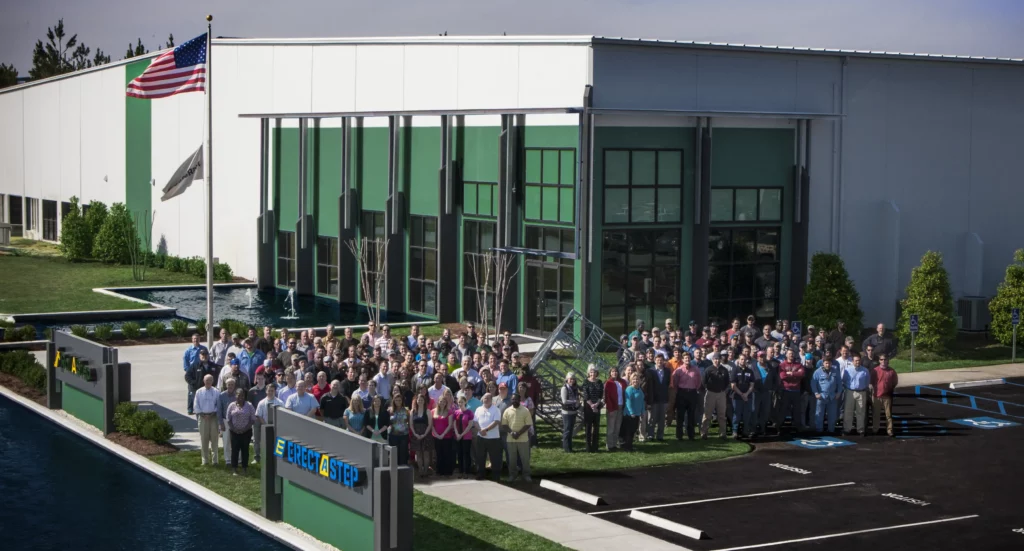Introducing the Counterweight-Based
Stair & Crossover Solutions

Accessing rooftop equipment such as HVAC units, ductwork, or piping requires safe, compliant, and non-disruptive infrastructure. ErectaStep’s counterweight-based rooftop stair and crossover system provides a secure, non-penetrating access solution that protects roof integrity while ensuring worker safety.

Non-Penetrating Rooftop Stair & Crossover System
ErectaStep’s Non-Penetrating Counterweight-Based System
Commercial
Rooftops
With no existing
anchor points.
Manufacturing and
Processing Plants
Requiring maintenance access to rooftop utilities.
Warehouses and
Distribution Centers
Needing compliant crossover systems that protect roofing warranties.
System Overview and Key Design Elements
This rooftop solution integrates ErectaStep’s modular aluminum platforms and stair assemblies with a galvanized steel base equipped with integrated counterweight trays. The trays hold powder-coated steel weights and neoprene load-distribution strips, which stabilize the structure while preserving the roofing surface.
- Non-Penetrating Support: This type of support eliminates the need for drilling or anchoring into the roof membrane, preventing damage and reducing installation time.
- Counterweighted Stability: Powder-coated steel weights and a widened base ensure a stable footprint in wind conditions up to 115 mph, ideal for open or elevated rooftop environments.
- Durable & Weather-Resistant: Built from corrosion-resistant aluminum and galvanized steel for long-term performance in harsh climates.
- Slip-Resistant and OSHA-Compliant: All treads and platform surfaces meet OSHA standards for fall protection and traction, minimizing safety risks.
- Standard Configurations: Pre-engineered options in 3-, 4-, 5-, and 6-step crossover heights accommodate various rooftop obstructions and elevation changes.
Common applications for rooftop stairs
- HVAC Access: Rooftop stairs can provide safe and easy access to HVAC units for maintenance and inspections. The non-penetrating design ensures the roof’s integrity, preventing leaks and other issues.
Installations - Pipe and Conduit Crossover: These stairs are ideal for crossing large conduits and pipes across rooftops. They provide a safe and compliant walking path, reducing the risk of trips and falls while avoiding direct contact with the roofing material.
Installations - Rooftop Equipment Access: Stairs can be installed to access other rooftop equipment, such as satellite dishes, antennas, or solar panels. This application ensures technicians can reach equipment without damaging the roof surface.
Installations
- Duct Crossover: Rooftop stairs allow safe crossing over large ductwork that might obstruct regular walking paths. This helps in maintaining a clear and safe route for personnel.
- Service Platforms: These stairs can lead to service platforms where workers can perform maintenance tasks on various rooftop installations like exhaust fans or cooling towers, ensuring safety and stability.
- Emergency Egress: In some cases, rooftop stairs are used as part of an emergency egress plan, providing a quick and safe way off the roof in case of an emergency.
- Rooftop Maintenance Pathways: Establish designated walking paths across rooftops using non-penetrating stairs, ensuring that maintenance personnel can safely traverse the roof without damaging the roofing material.
Counterweight vs. Tie-Down Systems
ErectaStep offers two distinct rooftop mounting solutions to meet varied structural and regulatory requirements: the counterweight-based system and the tie-down anchored system. Each method serves a specific application need, and understanding the differences can help facility managers and contractors choose the best option for their site conditions.
The counterweight system is a fully self-supporting solution that does not require any physical attachment to the roof. It relies on integrated galvanized trays loaded with powder-coated steel weights to provide mass and stability. This design is ideal for facilities with sensitive roofing materials, such as membrane or green roofs, where drilling or penetration could lead to leaks, warranty issues, or costly damage. Installation is faster and less invasive since it does not require structural anchoring, and the use of neoprene strips beneath the trays distributes weight evenly to prevent surface abrasion or deformation. Engineered to withstand wind speeds of up to 115 mph, this system provides secure and code-compliant access without permanent roof alterations.
In contrast, the tie-down system uses mechanical fasteners and rooftop shackles to anchor the stair and platform assemblies directly to the building structure. This approach may be preferred in locations where permanent anchoring is permitted or where existing tie-down infrastructure is already present. While this method can offer slightly higher rigidity in extreme conditions, it involves roof penetration, which may necessitate special permits, additional weatherproofing, and ongoing inspection to ensure long-term watertightness.
Choosing between these two mounting systems depends on site-specific variables such as roofing material, local building codes, exposure to wind loads, and installation constraints. The counterweight option provides greater flexibility and ease of deployment, particularly in retrofit or leased facilities, while the tie-down method is suitable for permanent installations where roof penetration is allowed.



